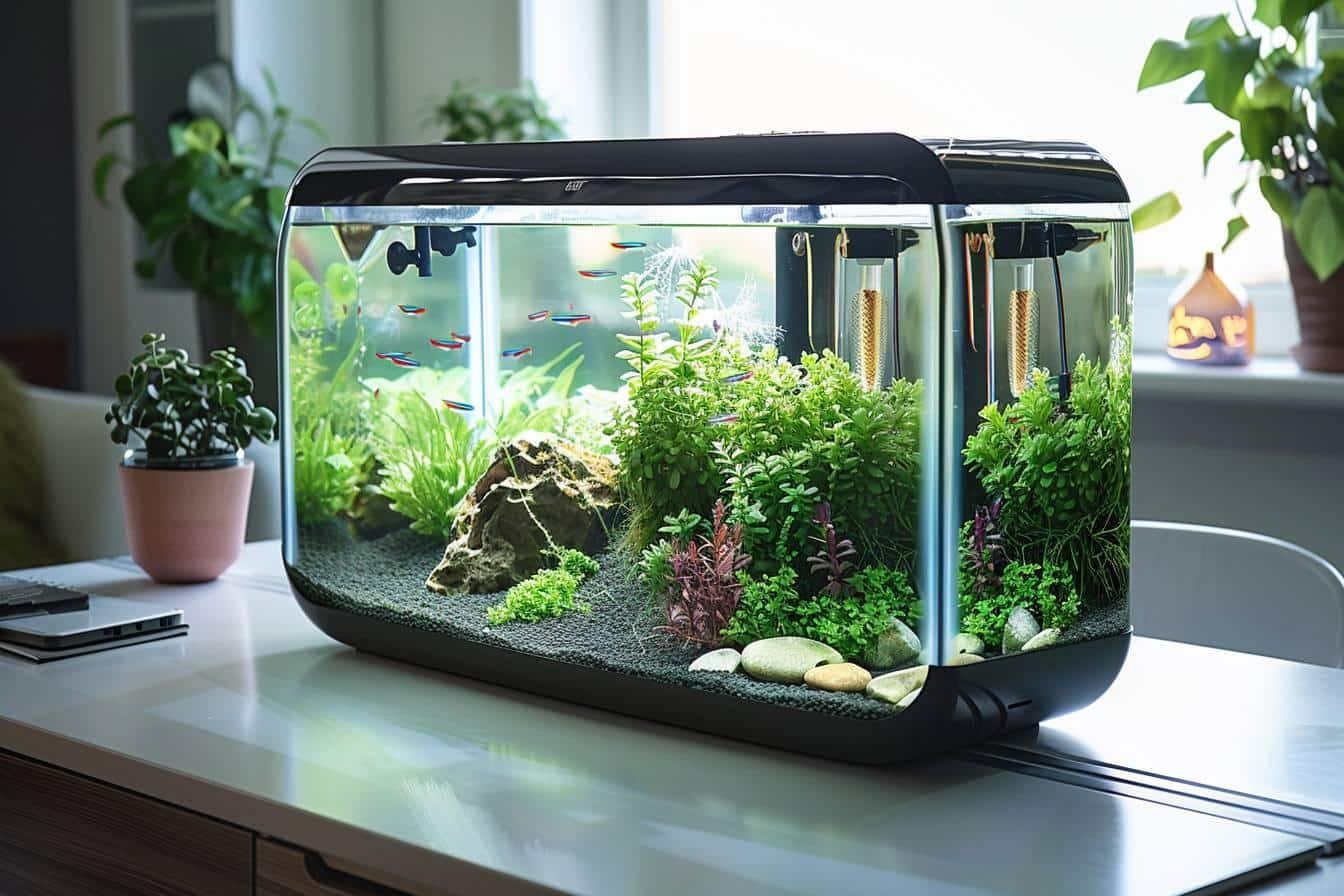The article in brief
Nano aquascapes are small aquatic ecosystems that combine art and nature. Here are the key points to remember:
- Tank Ultra-clear glass, rimless, from 4 to 90 litres
- Substrate mix of volcanic rock and nutrient substrate
- Plants a crucial role forecosystem balance
- Fauna small species such as neons or prawns
- Maintenance relatively simple, constant evolution to watch
Ah, the nano aquascapes ! This is a subject that has fascinated me ever since I discovered this exciting miniature world. As a pet shop floor manager, I can't help but marvel at these little aquatic ecosystems every day. Let me guide you through this captivating world where art and nature come together to create real aquatic jewels.
The basics of nano aquascape: a concentrate of nature
Choosing the ideal tank
The choice of tank is crucial to the success of your nano aquascape. Aquariums for this purpose are generally made of ultra-clear glass, with invisible joints and no edges. They come in a variety of shapes: cubic, rectangular or even special models such as high, low or long tanks. Sizes vary from 20x20x20cm to 45x27x30cm, with volumes ranging from 4 to 90 litres.
I remember my first nano aquarium. I opted for a 25x25x25cm cube, perfect for my desk. The sleek, aesthetic look of these little jewels is really appealing. Prices range from €35 to €280, depending on the size and quality of the glass.
The substrate, the pillar of the ecosystem
To create an environment conducive to aquatic life, the choice of substrate is vital. A mixture of porous volcanic rock and nutrient substrate is ideal. This cocktail ensures good water circulation and provides the nutrients plants need.
Here's a quick summary of the essential elements to get your nano aquascape up and running:
| Element | Features | Importance |
|---|---|---|
| Tank | Ultra-clear, rimless glass | Aesthetics and visibility |
| Substrate | Nutritious and porous mix | Plant growth |
| Lighting | LED, often USB (5V) | Photosynthesis |
| Decoration | Roots, rocks (e.g. Seiryu) | Aesthetics and shelters |
Lighting, a source of life
The right lighting is essential for plant growth. LED systems, often powered by USB (5V), are perfect for these small aquariums. They offer sufficient brightness while limiting energy consumption. Don't hesitate to play with the intensity to create different atmospheres throughout the day.
Creating a balanced ecosystem
The choice of plants, the keystone of nano aquascape
In a nano aquascapeplants play a crucial role. They don't just look good, they actively contribute to the balance of the ecosystem. I always recommend planting generously, as plants act as natural filters. Certain species, such as aquatic mosses or slow-growing plants, are particularly well-suited.
Here is a list of plants ideal for your nano aquarium:
- Anubias nana robust and easy to maintain
- Eleocharis parvula : perfect for creating a carpet of plants
- Bucephalandra : adds a touch of colour
- Microsorum pteropus : clings easily to scenery
Don't forget that some models are specially designed for wabikusa, these compositions of emergent plants that add a captivating vertical dimension to your creation.
Wildlife, a delicate choice
Choosing the inhabitants of your nano aquarium is essential. Small species such as Paracheirodon (neon) or bettas are perfectly suited. I fell in love with a group of cold water prawns in my first nano. These little crustaceans are fascinating to observe and play an active role in maintaining the aquarium.
But be careful not to overpopulate your small ecosystem. A limited number of individuals will be easier to manage and will guarantee a better quality of life for your aquatic residents. Don't forget to choose healthy fish from pet shops, as this is vital to the success of your project.
Filtration, natural or assisted
One of the most interesting aspects of nano aquascape is the ability to create a natural filtration system. Plants and substrate play a major role in this process. In some cases, it's even possible to do without a pump! It's fascinating to see how nature can regulate itself in such a small space.
If you opt for assisted filtration, choose discreet systems that won't disrupt the aesthetics of your creation. Miniature internal filters or cascade filters are excellent options. You could even consider a maintenance-free aquarium for your shrimpsThis is an ideal solution for beginners or people with little time on their hands.

Maintaining and upgrading your nano aquascape
Maintaining a nano aquascape is relatively simple, making it an ideal choice for an office or small space. On the other hand, there are some essential aspects that should not be overlooked. The start-up cycle is a crucial phase where you'll see algae. Don't be discouraged, this is a natural process that indicates that your ecosystem is being put in place.
Using rainwater or bottled water can be a good option for maintaining optimum water quality. Personally, I've opted for a mixture of reverse osmosis water and tap water, which gives me precise control over the water parameters.
Don't forget that your nano aquascape is a living ecosystem that is constantly evolving. That's what makes it so charming! Observe, adjust, and don't hesitate to renew your décor from time to time to keep the inspiration flowing. It's an exciting hobby that will allow you to develop your creativity while caring for a little piece of nature in your own home.
In the end, whether you're a beginner or a seasoned aquarist, nano aquascape offers a unique experience. It's an art form that combines aesthetics and the science of life. So, are you ready to dive into this miniature adventure?
External sources :
wiki aquaculture
wiki fish farming
